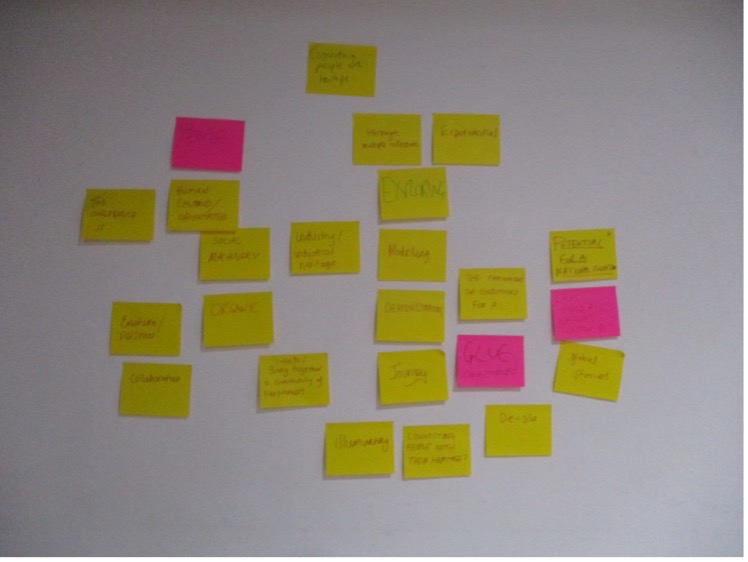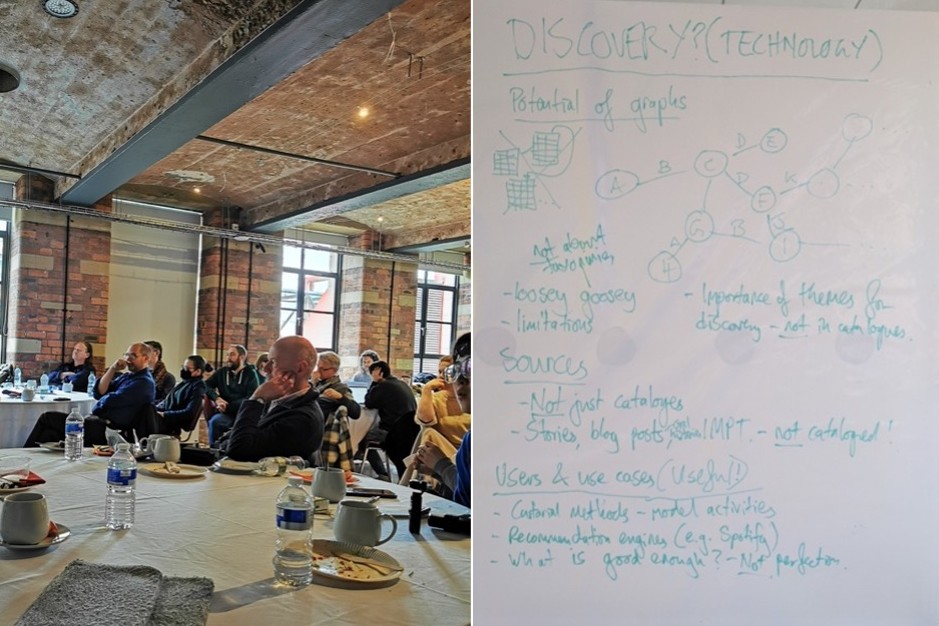Reflections from Arran Rees and Helen Graham, the co-facilitators of the action research for the project.
Between 9th and 11th February 2022, we held the opening conference of Congruence Engine in Bradford. In doing this, we situated the first in-person event in a well-known hub of Britain’s historic textile industry – an industry that is also the project’s first thematic focus. Spending two and a half days between Salts Mill in Saltaire and Lister Mills in Manningham, the project partners came together to get to know each other. We wanted to use the conference to understand more about each other’s interests, discover points of resonance between us, and help create a shared understanding of the project.
From early in the project’s inception, we knew we’d be using systemic action research (SAR) to run the project. Therefore, we wanted to ensure we were starting to use and embed the principles of SAR in the flurry of meetings, emails and presentations that happen around the start of a new big project.
We noted in a previous blog post on methods, that the following ideas felt like they would be particularly important to us throughout the project:
- We’re working with an expanded epistemology
- We are embracing multiple perspectives
- We’ll be working on multiple inquiries of varying scope and scale at the same time
- We seek resonance and make room for divergence
With those principles in mind, we aimed to practice what we preach at the conference and provide the opportunity for people involved in the project to experience how the principles we’d been talking about might look and feel in practice. We also wanted to experiment with putting those principles into action ourselves as co-facilitators of the action research. In a way, the opening conference became somewhat of a meta-action research cycle, for exploring how SAR could be used to live out its own principles in a project like Congruence Engine.

What did we do?
The conference programme was crafted to enable multiple forms of interaction between the attendees. These included lightning talks, film screenings, heritage encounters (guided walks and museum visits), Open Space Technology (see below), problem-solving sessions and the (partial) creation of a ‘North Star’ for the project.
The lightning talks were designed to enable people to share their own knowledge and explain their motivations for being part of the Congruence Engine. Throughout the course of the conference, we heard 21 lightning talks covering topics ranging from the industrial collections of Birmingham Museums Trust to how machine learning recognises kittens.
The film screenings punctuated talks with a different way of engaging; by prompting us to view, think and reflect on three different films from the BFI’s collection. These were: We Came Here to Learn a Trade (1956), Bradford: A Surprising Place (1981) and A New Kind of Match (1967). The films related to the textiles industry, Bradford as a place, and to migration and race. These were designed to spark conversation, and encourage reflection on the make-up of the project, as well as engagement with some of the range of collections that will be a part of the project.
We had two visits and chances to encounter the heritage surrounding us. On day two we were treated to a session with some of the Saltaire Collections before being taken on a guided walk around the town. On the third day, we spent the morning at the Bradford Industrial Museums, exploring the photography collections and seeing some of the working machine collections in action. These visits further embedded us within the history of our location and centred the objects and archives we had been talking about throughout the conference.

The Open Space Technology (OST) and problem-solving sessions were both designed to get people interacting with each other in different ways. OST [read more about it here] aimed to create an environment that allowed people to follow their own research interests, move between emerging and evolving conversations and participate in discussions that resonate with them. These conversations ranged from thematic topics like the history of energy, to institutional issues like internal processes for accessing and sharing collections data, and technical questions like the role of knowledge graphs in helping the discovery of connections between collections. Some of these may sow the seeds for new strands of research. On the other hand, the problem-solving session moved people into pre-defined groups, encouraging people to work in non-self-selecting ways. We wanted to help relationships form and flourish in instances of congruence as well as potential divergence.
Finally, we introduced the idea of the project’s ‘North Star’ at the beginning of the conference. Throughout the two and half days we invited attendees to note down on Post-It notes, the ideas, words and concepts that were resonating with them or occurring over and over again. The final session on day 3 was about trying to articulate our North Star – to find a set or words or even a sentence, collectively constructed, that we could refer to when thinking or discussing the project.

How did it go?
Overall, the conference really highlighted that the project is made up of an exciting group of people, with a wide range of interests and expertise, all bringing their own thoughts and ideas about what Congruence Engine is and could be. This really shone through in the lightning talks and as people moved between conversations during the two OST sessions. From a SAR perspective, the conference began to explore how an expanded epistemology for the project could be realised, and how to centre the multiperspectival nature of action research. It did this through offering opportunities to share theoretical, experiential, and interdisciplinary knowledge, as well as generate new thoughts and understandings through situated shared experiences. Through the OST sessions and the problem-solving session, we also experimented with allowing emerging concurrent discussions to take place, laying the ground for working across multiple inquires, and in self-selecting and self-directed groups.

The problems-solving session on day two felt like a particularly interesting change moment. We’d asked the groups to come up with activities for a public engagement session and some of them really ran with the idea, devising entire processes and events. However, others felt that we were not quite able to communicate what we were asking ‘the public’ to engage with yet. The conversations that stemmed from these moments of disagreement really helped clarify how enabling divergence and working with it could be hugely generative. They highlighted that we needed longer to build a mutual understanding of what Congruence Engine was working to achieve and led to a new plan being created to run a pilot project on data related to textile collections in and around Bradford. So, whilst the problem-solving session wasn’t a roaring success with regards to planning public engagement activities, it did help us kickstart a shift in our thinking about the next stage of the project, and in the process show the strength of SAR’s ability to embrace divergence and react to emergent issues.
The final North Star activity was designed to be more emergent from the onset. The session played out as a bit of an improvisation between us (Arran and Helen) to draw together the collective endeavor of the project. During the break before the session, we tried to categorise some of the ideas on the Post-It notes and to draw out themes. We agreed, last minute, to try and pull together a North Star sentence (which required a lot of energetic facilitation but felt like a potentially useful strategy). We asked people to yell out words and phrases, reflecting on why they were important. It made the end of the conference feel purposeful, energetic and as if we had achieved, at least in part, some of our collective aims. We got close to a North Star, and we’ll be sharing the further action and outcomes of that in a future blog.

(Image taken by Tim Boon)